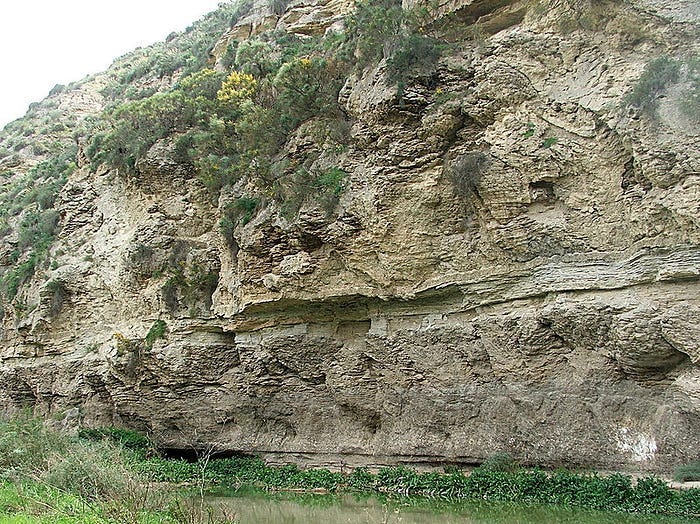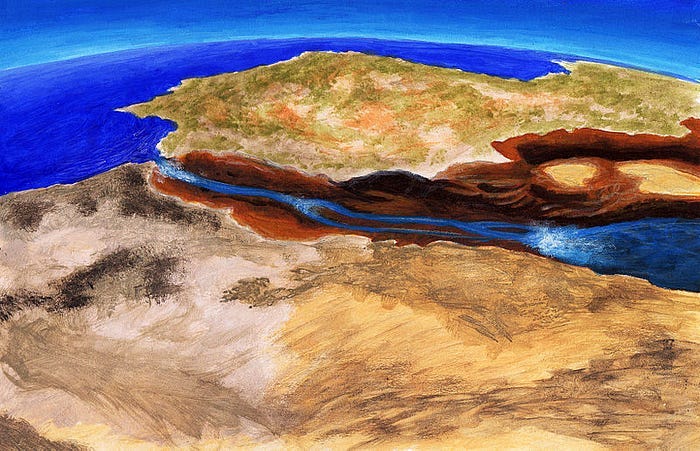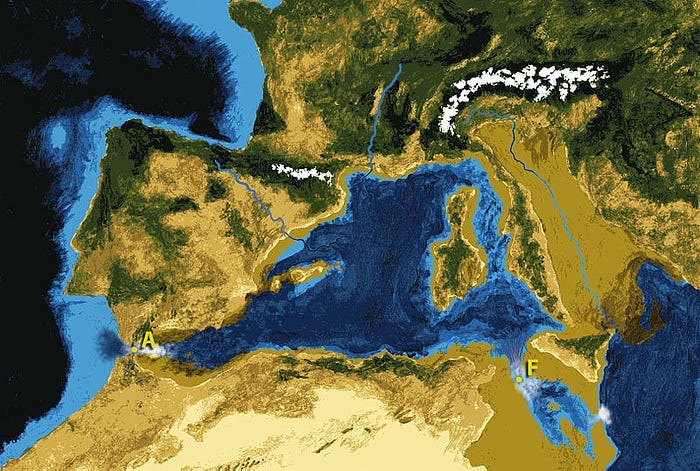
“90% of the flood water was transferred to the Mediterranean basin in a period lasting between only a few months and two years. According to the authors’ model, at peak discharge water poured in at a rate of 100 million cubic meters per second, cutting down into the bedrock by almost half a meter per day and possibly raising the level of the Mediterranean Sea by more than 10 meters per day.”
— Daniel Garcia-Castellanos. Nature 462, 697 (2009).
The Mediterranean Sea is a starring character in the history of many cultures. It was the stage of the First Punic War between Rome and Carthage. Previously it hosted the Battle of Salamis, the turning point between Greece and Persia.
In modern times it was the setting of the first aircraft carrier attack ever launched, on the Italian port of Taranto. But it did more than host battles. A German engineer and Nazi party member Herman Sörgel fantasized about draining it to plant crops for the good of humanity. Imagine that one for a second.
While this body of water could tell many incredible stories, its greatest may be its birth. While geography usually happens slowly over time, a theory proposes the Mediterranean Sea as we know it came about quickly and violently.
Think of a watery version of the Big Bang.
Unfortunately, the sea’s speculated birth stretches back over five million years. So, there are no eyewitnesses to corroborate. However, there is tantalizing evidence of a massive flood on the sea floor. Although, the term “massive” may not do it justice. Cataclysmic may be more appropriate.
This incredible tale isn’t told by historians, but scientists. Namely, geophysicist Daniel Garcia-Castellanos, a geophysicist at the Institute for Earth Science Jaume Almera in Barcelona, Spain. If true, it would be the largest flood in Earth’s history, according to Nature.
But before we can get to the flood, we need to understand why there was one. It starts with a retreat of water. Its evidence, massive layers of salt discovered at the bottom of the Mediterranean.
The Messinian Salinity Crisis
“About 5.96 million years ago this gap closed, initiating what is known as the Messinian Salinity Crisis, which lasted for more than half a million years before the Atlantic was reunited once more with the Mediterranean. The Messinian Salinity Crisis is so named because the closing of the strait to inflow from the Atlantic caused the Mediterranean to evaporate at a faster rate than the inflowing rivers could match. At pockets, some 3–5 kilometers below contemporary ocean-level.”
— On the Ocean: The Mediterranean and the Atlantic from Prehistory to AD 1500, Sir Barry Cunliffe
Nearly six million years ago, the connection between the Atlantic Ocean and the Mediterranean closed for some unknown reason. Mike Sowden at Everything is Amazing explains massive salt deposits were found at the bottom of the Mediterranean during the 1970s. When seawater evaporates it leaves salt and other sediment.
This is one of many reasons Herman Sörgel’s plan to plant crops in the recovered land by draining the Mediterranean would have never worked. Salt isn’t an ideal soil for farmers to say the least.
Moreover, some deposits were found to be two miles thick. Long contiguous layers of the seafloor are made of this salt. It was an indication of a major evaporation; something on an epic scale. Deposits of gypsum along the coast and layers of halite also confirm this idea.

Although Garcia-Castellanos and associates themselves point out in a paper in Earth-Science Reviews this is only one interpretation. No one knows exactly what the area looked like during this drawback. However, some indications still point to sea life being present, so some saltwater lakes of unknown size were thought to exist.
However, Snowden points out many scientists believe a “plug” only a few miles wide held back the massive Atlantic Ocean. Talk about a cliff hanger — a gigantic ocean, a small piece of land holding back the water, and an area drained of a former massive sea.
It sounds like the plot of a big budget disaster movie starring Dwayne “The Rock” Johnson.
The Zanclean Mega Flood

Daniel Garcia-Castellanos states in Nature he believes the flood started small over thousands of years. Imagine a small trickle of water. As it continued to run over the rock of the strait, it carved a channel and got bigger. More water and pressure built up, eventually exploding.
Garcia-Castellanos initially thought the computer models he was studying were a glitch. So, he looked for confirming evidence. His group found indications of a channel going from the Atlantic to the Mediterranean in seismic line data and rock core samples drilled for a train tunnel between Spain and Morocco.
Garcia-Castellanos and associates in their paper for Earth Science Reviews explain a 390 km erosion channel goes West to East through the Strait of Gibraltar into the Mediterranean.
“This erosion channel geometry varies from 2 km width and > 200 m depth in the Atlantic side (where it dissects the basement) to >15 km width and > 500 m depth in the Alborán Sea (where it erodes Miocene sediment).”
He also found many locations where large amounts of sediment were deposited throughout the Mediterranean that confirm a large flooding event. But were missing something here. What exactly would an event like this look like?
Now, the numbers aren’t very impactful just looking at them on a screen. So, Mike Sowden gives them some color. He compares the power of the Zanclean Mega Flood to the power of Niagara Falls to put it into perspective. Sowden says:
“Every second, around 2,400 cubic meters of water tumble over Niagara Falls, representing a total weight of around 3,100 tons, which pounds the base of the waterfall with a force of 2,509 tons. That’s every second, remember…the weight of an Airbus A380, currently the world’s largest passenger airliner, is a touch under 620 tons.”
He reminds the reader Garcia-Castellanos’ model shows the Zanclean Flood was 100,000,000 cubic meters of water per second at its peak point. So, this ancient flood pushed over 40,000 times as much water as the falls many are mesmerized by in the present day.

It’s unfathomable to think about that type of power but try to imagine it for a second. It makes the Battle of Salamis, the Punic Wars, and the attack on Taranto combined look like productions made by your high school A/V club.
Moreover, this one violent event likely set the stage for all that history to follow by creating the massive sea as a stage for all those things to take place. Not to mention, it might have created the Nile River.
A Scenario, Not Settled History
“In his Historia Naturalis (~77 AD), Pliny the Elder reports on a legend popular among the inhabitants of southern Iberia, telling how the Mediterranean Sea was born. According to this myth, the Mediterranean Sea was deserted and cut-off from the Ocean, and it was Hercules who dug an inlet with his sword between Jebel-el-Mina (Africa) and the rock of Gibraltar (Europe). This allowed the ocean to flow into the Mediterranean Basin, where ‘it was before excluded,’ thus ‘changing the face of Nature’”
— Daniel Garcia-Castellanos and associates, Earth-Science Reviews, Volume 201, 2020,
Ancient history is difficult to study. Imagine taking small pieces from your town or city and putting them in the hands of a culture that’s living a thousand years in the future. Could they make logical sense of your life?
The future researchers could make assumptions and might be right about many things. However, understanding your full life would be difficult at best. Now, let’s stretch this to prehistory, before there were people.
You can only look at geographic indicators and bones to interpret events from millions of years ago. Your stuck looking at salt, gypsum, and halite. Then, you can intermix some marine fossils here and there. Imagine the difficulties now.
I’m sure you’ve noticed I use words such as likely, might, and possibly many times. Mainly because these events occurred over five million years ago. No one knows for sure. Daniel Garcia-Castellanos and his associates have only proposed a theory, all be it an interesting one with evidence behind it.
He also points out there have been other mega floods: The Missoula Floods in Washington State and The Altai Flood in Russia.
But others believe the Mediterranean refilled gradually over time, like most geographic events. So, this discussion is likely to be something battled over by scientists for years. However, the Zanclean Mega Flood makes one hell of a story.
It would be an appropriate beginning for an area with such amazing history. In a way, a watery Hercules might have dug out the famous Gibraltar inlet in an unprecedented violent strike, setting the stage for endless events to follow.
-Originally posted on Medium 4/5/2022


